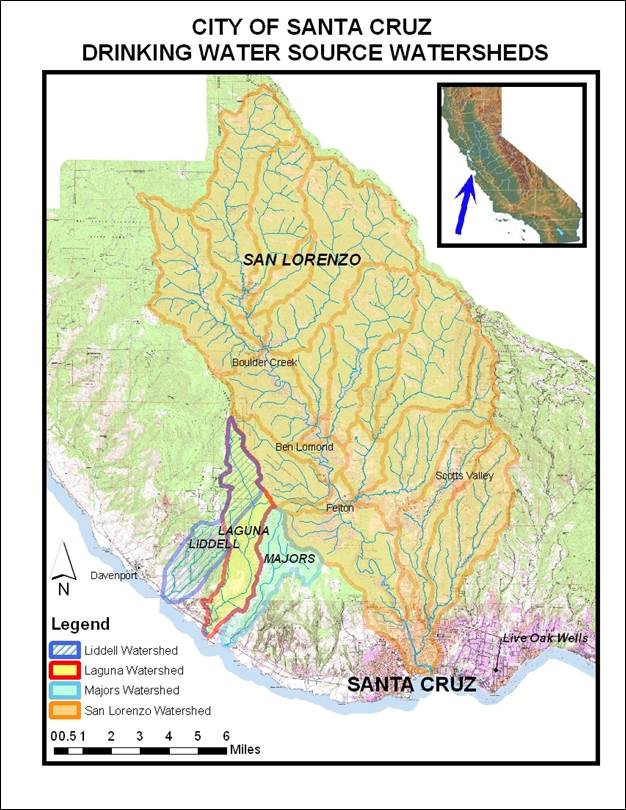CZU Fire - Water Quality
CZU Lightning Complex Fire and Water Quality
Impacts to the Santa Cruz Drinking Water System
Introduction
The August 2020 wildfire that burned in the Santa Cruz Mountains touched many watersheds, including some that provide drinking water for City of Santa Cruz Water Department customers. While the wildfire did impact portions of our watersheds, there was no damage to our distribution system or Water Department facilities. This page provides information specific to the fire’s impacts to the City of Santa Cruz municipal drinking water system. For more general information about the CZU Complex fire, please visit the County of Santa Cruz Fire or Cal Fire websites.
Frequently asked questions about impacts to water quality from the CZU Fire(PDF, 403KB)
Potential Watershed Impacts
The impact of wildfire on a watershed is highly variable. The CZU Lightning Complex Fire burned nearly 20% of the San Lorenzo River watershed and the headwaters and upper reaches of the North Coast watersheds, including Laguna Creek, Liddell Creek, and Majors Creek, which are all sources of drinking water supply for the City of Santa Cruz. The San Lorenzo River typically supplies almost half of the City of Santa Cruz’s drinking water, therefore the impacts to its watershed may have the greatest influence on water quality and the treatment process. However, due the large number of damaged homes and industrial buildings containing chemicals, computers, cars, and other household items, it is expected that there will be impacts in all affected Santa Cruz watersheds to varying degrees. The Loch Lomond Reservoir and surrounding watershed was not affected by the wildfire.

Potential Water Quality Impacts
Wildfire can have significant impacts on the chemical, microbiological, and physical properties of raw source water and therefore affect the water treatment processes. The impacts to source water quality can depend on many factors including the extent and intensity of the wildfire, post-wildfire precipitation, fire watershed topography, and local ecology. Large and fast river and stream flows from burned areas can pick up and transport large amounts of debris, sediment and chemicals that significantly affect the water quality and use downstream. Additionally, runoff from the burned areas and tributaries that flow into source water may contain ash, which can contain higher nutrient levels, chemicals, organic carbon, sediment, metals, and suspended solids to enter the water during high flow winter storm events. You can see the severity of the burn damage on this map(PDF, 510KB).
Overview of Soil and Water Quality Monitoring
The City of Santa Cruz Water Department takes its responsibility for providing the community safe and reliable drinking water very seriously and ensures that the water meets or exceeds the California State Water Resources Control Board and U.S. Environmental Protection Agency’s drinking water standards. The City of Santa Cruz Water Quality Laboratory routinely monitors the water system including the raw source waters, the treatment plants, and the water distribution system for regulated and non-regulated compounds. In addition to this routine monitoring, we have developed a comprehensive soil and source water sampling program for this water year to actively monitor our watersheds for any potential changes in water quality due to the CZU Lightning Complex Fire. Data collected from this program will be used to assist in water treatment decisions and source selection at the Graham Hill Water Treatment Plant. You can see the parameters used to monitor water quality on this chart(PDF, 23KB).
Related Documents
We will add information to this page as it becomes available. Please check back.